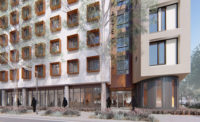The designers of Seattle’s Bullitt Center have overachieved. The Miller Hull Partnership, co-founded by the late Robert Hull, set out to demonstrate that a six-story office building could generate all of the energy it needs, but after one year of operation, it is sending a sizable energy surplus to the local power grid, according to data released by its developer, the Bullitt Foundation.
Consumption is simply far lower than what Miller Hull and the m/e/p engineers, PAE, projected for the 52,000-square-foot building. Instead of using 16kBtu per square foot—half the energy-use intensity (EUI) of Seattle’s best-performing office building—consumption during its first year was just 10kBtu/sf.
PAE president Paul Schwer estimates that the building’s EUI will still be just 12kBtu/sf when its last unoccupied floor is leased. At that level, the energy flowing from the solar array on its cantilevered roof—sized to just offset the building’s projected energy consumption—will also offset electricity use for about dozen neighboring houses.
Denis Hayes, the Bullitt Foundation’s president, says that no commercial building comes close to the Center in terms of energy efficiency. He calls that a coup for the designers, who integrated a suite of energy saving strategies including 14-foot floor-to-floor heights, triple-glazed windows, and passive climate controls. “We’ve figured out a way to dramatically reduce energy consumption without any sacrifices of comfort or lighting,” says Hayes.
Schwer says the takeaway is that net zero energy office buildings are viable, even in overcast Seattle, which he adds is “literally in the cloudiest climate in the lower 48 states.” And it works in less temperate climates, too. He has modeled operation of the Bullitt Center in 15 other cities across the U.S. and even in notoriously frigid Minneapolis, its energy budget zeroes out.
But Schwer and Miller Hull principal Brian Court say they must share credit for the Bullitt Center’s performance with the building’s occupants, whose lower-than-expected plug loads account for most of the energy surplus. Schwer says PAE, which decided two years ago that it would relocate to the Bullitt Center, has since slashed power use per workstation by 80 percent by replacing computing equipment. An incentive scheme devised by Hayes will help keep tenants engaged: each has an energy allowance, and only pays for the electricity consumption that exceeds that budget.
While the Bullitt Center excels at generating energy, it has struggled to deliver on projected water savings. A rainwater purification system, for example, remains inoperative due to concerns from regulators that it could pick up contamination from bathroom taps. Hayes has worked hard to overturn a chlorination order, even approaching the EPA. Having now agreed to chlorinate the rainwater, Hayes awaits final approval to start the system. He expects to have it running well before January 2015, when the building will have been at 85 percent or greater occupancy for a year and he can file for Living Building certification.









Post a comment to this article
Report Abusive Comment